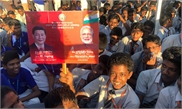
Students from Mamallapuram, an ancient coastal town in southeastern India, welcome Chinese President Xi Jinping on Friday. Photo: Cao Siqi/GT
At the invitation of Prime Minister Narendra Modi, Chinese President Xi Jinping began his visit in India on Friday for his second informal meeting with Modi in the southern Indian city of Chennai. This is one of this year's most anticipated summits.
In April 2018, the first informal summit between Xi and Modi in Wuhan pulled bilateral relations back on track from the shadow of the Doklam standoff. Exchanges and cooperation in various fields have been comprehensively promoted. This time, the meeting in Chennai will set the tone and direction for the next stage of China-India ties while providing stability and positive energy for the current world full of uncertainties.
Public opinions from China and India have been very positive toward the second Xi-Modi informal summit, yet a few Western media are focusing on differences between the two. This is not unexpected. Some people in the West have been constantly driving a wedge between Beijing and New Delhi, hoping to see frictions or even clashes break out.
People with even a slight political sense know why the US and the West do not want China and India to be close to each other, and why they hope to see a fight between the Chinese dragon and Indian elephant, because the two emerging powers could consume their energies while the West gains strategic benefits. Although some Indian media tend to make impulsive statements from time to time, Indian policymakers have maintained strategic rationality and geopolitical sense. Both countries have gradually formed an increasingly stronger ability to control their problems.
China-India relations are complicated given their border disputes, historical grudges and respective concerns on geopolitics. Any of these differences could lead to fiercer conflicts stimulated by nationalist sentiments and the intervention of foreign forces, which would disturb the bilateral relationship.
In the past decade, overall peace and rapid development have prevailed between the two amid differences and frictions. That's because the leaders of both countries have a clear understanding over the key issue - friendly cooperation is in line with China and India's fundamental strategic interests.
Chinese society is full of goodwill to India and hopes to see India achieve peaceful development. They should expand their friendly collaboration. The two countries are adjacent to each other. Both sides should turn this into a driving force of their own development, rather than using it for conflicts. We believe, guided by leaders from the two sides, ties between China and India would become a significant factor in defining international relations in the future.

